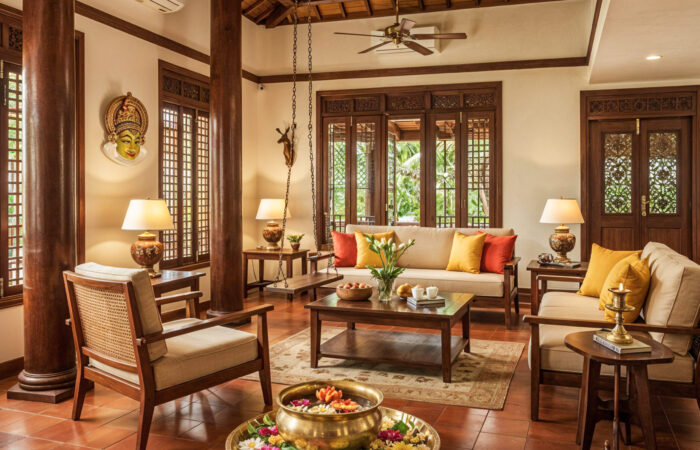Kerala, known for its lush landscapes, vibrant culture, and rich architectural heritage, offers a wealth of traditional design elements that can elevate modern interiors. The state’s unique fusion of functionality and aesthetics provides a perfect template for blending classic and contemporary styles. This guide will help you explore how to merge Kerala’s traditional elements with modern design principles, bringing timeless elegance and cultural richness into your home. Traditional Kerala architecture is deeply rooted in the state’s climatic conditions, social structure, and cultural values. Kerala’s design ethos emphasizes open spaces, natural ventilation, and harmony with nature, all of which are increasingly relevant in today’s eco-conscious world. Modern homeowners and designers are looking for ways to incorporate these traditional elements into contemporary homes to create spaces that are not only functional but also imbued with history and cultural significance.
Kerala’s tropical climate, with heavy monsoons and humid weather, significantly influenced its architectural choices. Sloping roofs, natural cooling techniques, and integration with nature are hallmarks of Kerala’s traditional designs that make them adaptable to today’s lifestyle needs.
1. Understanding Traditional Kerala Architecture & Design Elements
To seamlessly integrate Kerala’s traditional elements into modern interiors, it’s essential to first understand the key features that define Kerala’s architectural and design heritage. These elements were not only beautiful but also practical, ensuring comfort and functionality in the region’s unique climatic conditions.
a) Core Features of Traditional Kerala Homes
- Sloping Roofs & Clay Tiles: The heavy monsoon rains in Kerala made sloping roofs an essential feature of traditional homes. These roofs, often made of clay tiles, were designed to withstand the weight of rainwater and to help in maintaining temperature control within the house.
- Nadumuttam (Central Courtyard): A central courtyard, or ‘Nadumuttam,’ is a key element of traditional Kerala homes. This open space provides ventilation, natural light, and a sense of openness. It serves as a hub for family gatherings and also connects various parts of the home.
- Wooden Structures & Carvings: Kerala homes are known for their intricate woodwork, especially using teak and rosewood for pillars, beams, and furniture. The carvings often depicted traditional motifs and animals, adding both beauty and cultural value.
- Red Oxide & Athangudi Tile Flooring: Red oxide floors and Athangudi tiles (handcrafted tiles made from clay) were traditionally used in Kerala homes for their cooling properties, which are ideal for hot and humid climates.
- Mural Paintings & Wall Art: Kerala’s mural paintings, depicting mythological stories, cultural scenes, and religious icons, were an integral part of home décor. These paintings are known for their vibrant colors and intricate details.

b) Symbolism & Cultural Influence
Kerala’s design philosophy is influenced by Vastu Shastra, the ancient Indian science of architecture. Vastu emphasizes creating spaces that promote health, happiness, and prosperity by aligning with natural forces. Kerala’s architectural layout also underscores the importance of open spaces and a connection with nature. These principles can still be found in modern homes, where the flow of air and light, as well as the balance between indoors and outdoors, is a priority.
2. How to Blend Traditional Kerala Elements into Modern Interiors
Now that we understand the essential elements of Kerala’s traditional design, let’s explore how to seamlessly integrate them into modern homes.
a) Architectural Fusion
- Modern Homes with Sloping Roofs: While sloping roofs may seem outdated for urban homes, they can be adapted using modern materials like metal or concrete. You can retain the traditional sloping form while incorporating modern design elements. Using Mangalore tiles for the roof will maintain the authenticity of the Kerala style.
- Courtyards (Nadumuttam) in Compact Homes: Even in smaller homes, you can incorporate the concept of a central courtyard. Skylights, indoor gardens, and open-plan layouts can mimic the traditional feeling of an airy, spacious courtyard, improving the flow of light and air within the home.
b) Materials & Finishes
- Woodwork: Kerala homes are known for their beautiful woodwork. Incorporate intricately carved wooden panels as room dividers, headboards, or even as decorative elements in walls. Opt for Kerala-style solid wood furniture, such as teak, rosewood, or mahogany, to keep the traditional feel alive.
- Flooring Choices: Red oxide floors can provide a vintage and traditional look, while also offering natural cooling in hot climates. If you want a more vibrant feel, Athangudi tiles are a great option for kitchens and bathrooms, as they evoke the traditional Kerala heritage.
- Stone and Brass Accents: Introduce brass accents like Nilavilakku (brass lamps), door handles, and bell chains to your interiors for a traditional touch. You can also add texture to the walls with exposed laterite stone, commonly used in Kerala architecture for its earthy feel.
c) Traditional Kerala Furniture & Decor
- Chettinad-style or Wooden Furniture: Low-seating wooden sofas with cane or jute upholstery evoke the charm of Kerala’s traditional seating arrangements. A traditional swing (Oonjal) can be a unique addition to a living room or balcony, providing both comfort and aesthetic appeal.
- Handloom Fabrics & Curtains: Incorporate Kerala’s famous Kasavu fabric (gold-bordered) for curtains or upholstery. These materials add a cultural touch to modern homes, especially when paired with soft linen or cotton, blending both traditional and contemporary styles.
- Mural Art & Local Handicrafts: Feature traditional mural paintings on a focal wall to bring in the cultural richness of Kerala. Additionally, display handcrafted wooden artifacts like Kerala Nettipattam (brass embellishments used on elephants) or brass lamps to add a personal and authentic touch to the space.

d) Modern Kitchen with Traditional Influences
In the kitchen, you can blend modern modular designs with traditional Kerala elements. Opt for wooden or cane-finish cabinets and incorporate brass or copper utensils as decorative items. A tiled backsplash featuring intricate Kerala motifs will provide a sense of tradition while maintaining the sleek, clean lines of a modern kitchen.
e) Kerala-Inspired Lighting
Lighting plays a crucial role in creating the right atmosphere. Use brass hanging lamps (Thookkuvilakku) for warm lighting. Mixing traditional oil lamps with modern pendant lights can also create a unique blend of the old and new. A combination of dim lighting and natural light sources can give the space a cozy, inviting feel.
f) Indoor & Outdoor Integration
- Traditional Verandas with a Modern Twist: A traditional charupadi (seating area) can be combined with modern railings and sleek furniture to create a perfect outdoor relaxation zone. The integration of outdoor spaces with nature is a core element of Kerala’s architecture.
- Lush Greenery & Water Elements: Kerala’s natural beauty is often reflected in the integration of water features and tropical greenery. Incorporate plants like Areca Palm, Banana Leaf, or even a mini water feature like an uruli (brass bowl with floating flowers) to add a calming, nature-inspired vibe to your living spaces.

3. Practical Tips for a Balanced Look
When blending traditional and modern elements, striking a balance is key:
- Do’s & Don’ts of Fusion Interiors:
- Do: Focus on simplicity and restraint to avoid overcrowding the space with traditional elements.
- Do: Maintain a balance between neutral, modern tones and vibrant, Kerala-inspired patterns.
- Don’t: Overload the space with too many heavy wooden structures or decorative pieces. Let each element stand out.
- Customizing Traditional Designs for Small Homes:
- Use wooden panels as room dividers instead of full pillars to save space.
- Create a mini-nadumuttam by converting a window bay into a small indoor garden with a skylight.
4. Cost Considerations & Budget-Friendly Ideas
Incorporating traditional Kerala elements doesn’t have to be expensive. Here are a few ways to achieve this look on a budget:
- Source traditional materials like Athangudi tiles or wooden panels from local artisans to get better prices.
- Use laminate wood instead of solid teak for furniture or flooring for a more affordable alternative.
- Consider DIY mural art or wall decals to achieve the look of traditional Kerala murals without the high cost.
Conclusion
Blending Kerala’s rich heritage with modern design elements allows you to create a home that is both functional and culturally rich. Whether it’s through the use of traditional materials, furniture, or décor, there are endless ways to incorporate Kerala’s architectural elements into your modern living spaces. Experiment with these ideas to create a home that tells a story of tradition, culture, and timeless elegance.
At Faboolux, we specialize in creating customized interior designs that seamlessly blend traditional charm with contemporary elegance. Whether you’re looking to infuse Kerala’s rich cultural elements into your modern home or need expert advice on curating a timeless living space, our team is here to bring your vision to life. Contact us today for a free consultation and let us help you craft a unique, aesthetically pleasing home that reflects both heritage and modernity.

